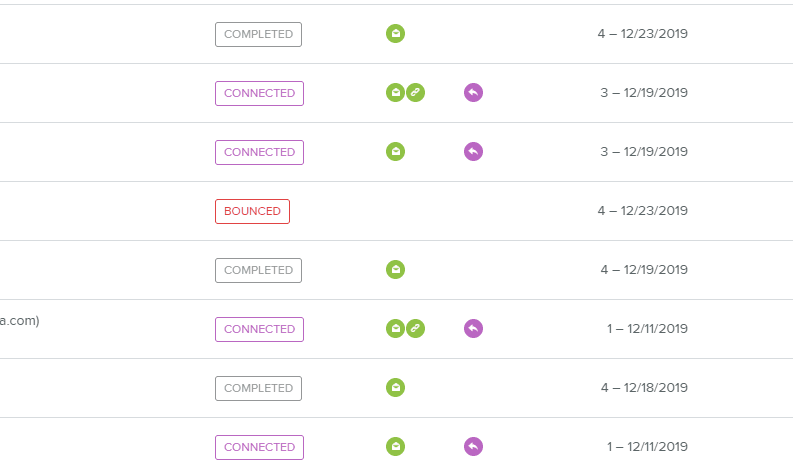Decrease Your Email Bounce Rate With These Best Practices
Jenny Keohane
Do you know your current email bounce rate? If you’re frequently sending email campaigns, this is an important metric to stay on top of, and you should manage email bounce backs responsibly after every sent campaign.
Unfortunately, high bounce rates hurt your email deliverability.
Fortunately, an email bounce means you get an error message back, which allows you to uncover the problem.
But not all bounces are created equal – it’s important to know the different kinds of bounces, what factors cause each, and how to act on them accordingly. Keep a good email reputation, boost email engagement, and improve deliverability by reviewing these email bounce-back best practices.
What Is a Bounced Email?
A bounced email is when you receive an error email indicating that your message failed to deliver to your intended recipient. Your email is either rejected by the recipient’s email server or possibly your own mail server. There are 2 types of email bounces:
- Soft bounces
- Hard bounces
1. Soft Bounce Email
Soft bounce emails are a temporary issue – these typically mean that the email address is valid but the recipient is temporarily unavailable such as their mailbox is full or their server is down.
Good news: most email services will attempt to resend the message after a soft bounce occurs, but if not – resend the message yourself at a later time.
What are the common causes of soft bounces?
- The recipient’s mailbox is full
- The server is down
- Message size is too large
- Account is temporarily down
2. Hard Bounce Email
Hard bounces are unfortunately permanent issues – your email is undeliverable. These are the bounces that really hurt your bounce rate. Hard bounces mean that the email address failed or was rejected by the server. This is often a sign of an old and outdated email list. The best thing you can do to protect your bounce rate is never re-send emails to addresses that received a hard bounce.
What are the common causes of hard bounces?
- Invalid email address
- Email address doesn’t exist
- Email blocked
- Outdated domain
What Is the Average Email Bounce Rate?
Email bounce rates are calculated by the number of bounced emails divided by the number of sent emails. These indicate your email reputation – you should always stay on top of this number.
Mailchimp’s extensive email study helps identify average bounce rates for us.
Average hard bounce rate across all industries = 0.40%
Average soft bounce across all industries = 0.58%
Campaign Monitor suggests that the benchmark bounce rate for is less than 2% – anything above 2% bounce rate is worthy of your attention. The data also suggests a bounce rate over 5% suggests a significant problem that should be resolved immediately.
How to Interpret Common Bounce Replies
Gmail Help provides some common bounce replies and what they mean. These error messages help indicate why your message bounced. Never disregard these – always read them and act accordingly.
“The email account that you tried to reach does not exist”
This message means that your recipient’s address might not work or exist anymore. Remember, you could have made a typo while typing the email address, so always double-check this before assuming otherwise.
“Message flagged as spam” or “Message temporarily rejected”
This message means that your message text or links look suspicious. This can also occur if you add large groups of recipients to Cc or Bcc.
“Recipient server did not accept our requests”
This message occurs when Gmail can’t connect to your recipient’s email server. This problem typically resolves on its own, but if not, try to re-send the email at a later time.
Tip: if you see a high number of bounces after sending out an email campaign – this could indicate that you got flagged by spam filters – review these guidelines to avoid spam.
Tips for Decreasing Your Email Bounce Rate
- Remove hard bounces
- Keep your email lists clean
- Keep track of your email deliverability
- Send emails regularly
- Authenticate your emails
- Use a preference center
1. Remove hard bounces
When you get a hard bounce, remove the address from your email list. Avoid sending any more messages to this email address because it will affect your email deliverability, bounce rate, and even the likelihood of flagging spam filters.
2. Keep your email lists clean
Maintain good list hygiene by regularly cleaning up your email list which will help limit bounce rates and keep email deliverability high. Starting with a quality list helps a lot. There are plenty of email list-building tools that can turn website visitors into opt-in contacts. Make sure your list is up-to-date with all active and current email addresses and get rid of all unsolicited emails.
3. Keep track of your email deliverability
Low engagement and high bounce rates will give you a bad-sender reputation, always stay on top of your email performance to never let it get to the point of damaging your email deliverability. The longer you leave bounce issues unresolved, the greater the damage to your sender reputation. Always monitor the results of your campaigns.
4. Send emails regularly
This will help reduce high bounce rates because you are regularly interacting with your subscribers. This results in higher engagement and keeps you on top of all active email addresses.
5. Authenticate your emails
Authenticating your messages helps the receiver and provider confirm you’re a legitimate sender. Mailbox providers may reject your message if not. Your recipients’ servers are much more likely to bounce or even junk your emails if they can’t determine the legitimacy of the message.
6. Use a preference center
Give your subscribers control over what they’re receiving – this will ensure accurate email addresses and recipients who know they’re receiving certain messages from you. Also, adding a preference center link to your messages can help encourage recipients to update their email addresses.
Yesware Best Practice: Yesware users are in good hands when it comes to bounced emails – we will not count a bounced email as a reply, you can view which emails bounced in your campaign, and you will receive a report on the bounced email in your Tracking Report. Also, when we detect email bounces after a campaign has been sent, we remove the recipient from any pending future touches.

Mail Blocks: Spam
The black hole of a spam folder is the worst-case scenario – no indication or chance to fix your mistake. We dug up the top 5 reasons why emails go into spam as well:
- You have low engagement rates
- You are not updating and cleaning your email lists
- Your content is flagging spam
- You’re using spam trigger words
- You’ve included an attachment
1. You have low engagement rates
The more engaged your recipients are with the emails you’re sending, the more likely you are to reach your recipient’s inbox.
2. You are not updating and cleaning your email lists:
As discussed above, keeping your email lists clean plays a huge role in preventing your emails from going to spam. Your email list should consist of legitimate addresses and valid opt-ins from the recipients.
3. Your content is flagging spam (body of email and subject line)
Avoid all caps, avoid using multiple exclamation points, watch for spelling or grammatical errors, and personalize your messages.
4. You’re using spam trigger words
There are certain words and phrases that you should avoid using in emails and subject lines. Spam filters pick up on spam-like words, especially in your subject lines. Review some top spam trigger words to avoid using here.
5. You’ve included an attachment
Attachments alert filters of a possible virus. Our tip to avoid getting flagged as spam by your recipient’s email filters is by using descriptive links – for example, use Yesware rather than www.yesware.com
Improve Your Email Deliverability
In order for your email campaign to be successful – your email must be delivered.
Decrease your bounce rates and improve email deliverability by using these tips and monitoring your email activity and reports so you never let an easily fixable error affect your sender reputation.
Get sales tips and strategies delivered straight to your inbox.
Yesware will help you generate more sales right from your inbox. Try our Outlook add-on or Gmail Chrome extension for free, forever!
Related Articles
Jenny Keohane
Jenny Keohane
Melissa Williams
Sales, deal management, and communication tips for your inbox

